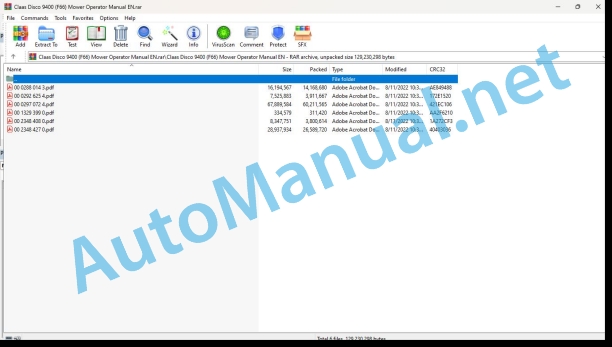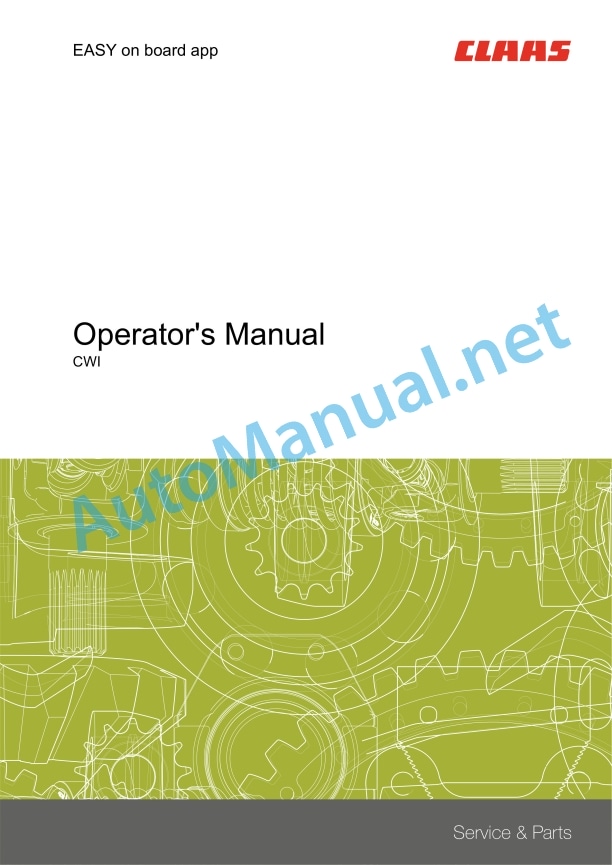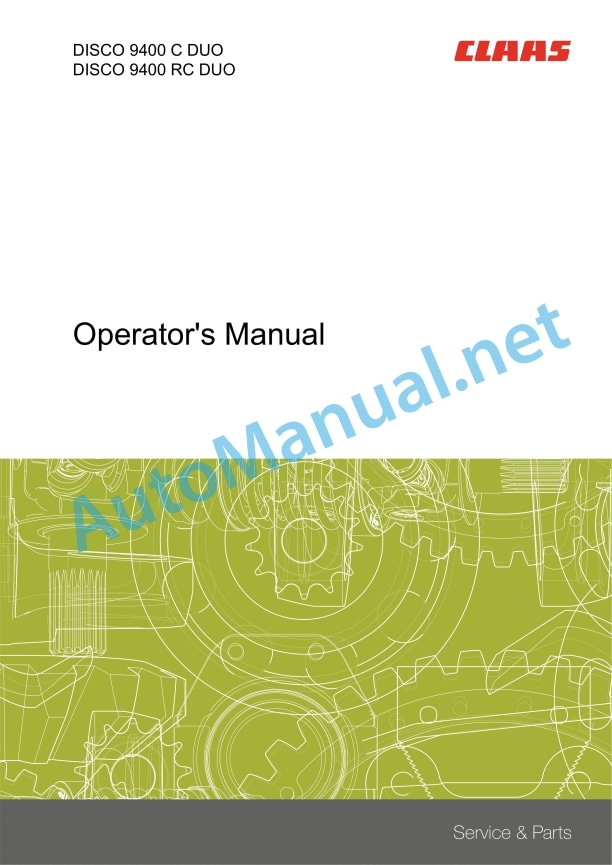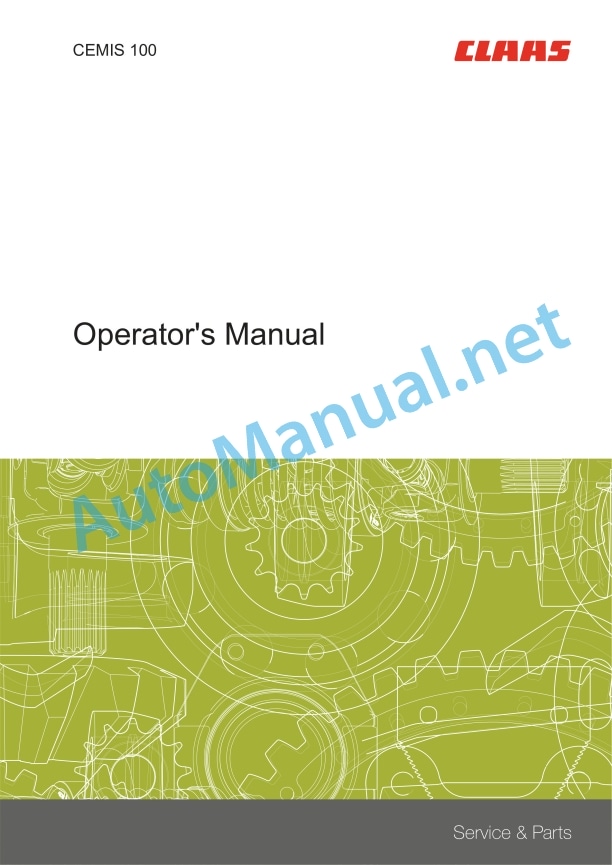Claas Disco 9400 (F66) Mower Operator Manual EN
$50.00
- Model: Disco 9400 (F66) Mower
- Type Of Manual: Operator Manual
- Language: EN
- Format: PDF(s)
- Size: 104 MB
File List:
00 0288 014 3.pdf
00 0292 625 4.pdf
00 0297 072 4.pdf
00 1329 399 0.pdf
00 2348 408 0.pdf
00 2348 427 0.pdf
00 0288 014 3.pdf:
EASY on board app
Table of contents
1 Introduction
1.1 General information
1.1.1 Validity of the manual
1.1.2 Information about this Operator’s Manual
1.1.3 Symbols and notes
1.1.4 Qualified specialist workshop
1.1.5 Maintenance notes
1.1.6 Notes on warranty
1.1.7 Spare parts and technical questions
1.1.8 Technical requirements
1.2 Intended use
1.2.1 Intended use
1.2.2 Reasonably foreseeable misuse
2 Safety
2.1 Identifying warnings
2.1.1 Hazard signs
2.1.2 Signal word
2.2 Safety rules
2.2.1 Meaning of Operator’s Manual
2.2.2 Requirements made on all persons working with the product
2.2.3 Hazard areas
2.2.4 Check interactions with self-propelled machines / tractors and implements
2.2.5 Structural changes
2.2.6 Optional equipment and spare parts
2.2.7 Technical status
2.2.8 Hazard caused by damage to the product
2.2.9 Visibility of work area
2.2.10 Glare and reflections
2.2.11 Unintentional triggering of functions
2.2.12 Hazards caused by signal tones
2.2.13 Unauthorised use
2.2.14 Use of mobile terminal outside the cab
2.2.15 Follow the safety instructions
2.2.16 Respecting technical limit values
2.2.17 Preparing the product for road travel
2.2.18 Hazards when driving on the road and on the field
2.2.19 Hazards when driving on the road with an ISOBUS implement
2.2.20 Switching off the mobile terminal while driving
2.2.21 Hazards from disturbance of WLAN environment
2.2.22 Hazards from covering up the App
2.2.23 Hazards caused by malfunctions of the app
2.2.24 Raised machine parts and loads
3 Product description
3.1 Overview and method of operation
3.1.1 Overview of CWI
3.1.2 Functions of CWI
3.2 Identification plates and identification numbers
3.2.1 CWI identification plate
3.3 Information on the product
3.3.1 Factory settings
3.3.2 Software and hardware version
3.3.3 Seal on the CWI
4 Operating and display elements
4.1 CLAAS Wireless Interface (CWI)
4.1.1 CWI operating elements
4.2 CWI Setup App
4.2.1 Overview of screen
4.2.2 Buttons
4.2.3
4.2.4
4.2.5
5 Technical specifications
5.1 CLAAS Wireless Interface (CWI)
5.1.1 Specification
6 Preparing the product
6.1 Installing the product
6.1.1 Installing the CWI Setup app
6.1.2 Installing the EASY on board app
6.1.3 Connecting the tablet
7 Operation
7.1 Initial operation
7.1.1 Establishing the WLAN connection for the first time
7.1.2 Changing factory settings
7.1.3 Establishing the WLAN connection
7.2 CWI Setup App
7.2.1 Calling up menus
7.2.2 Establishing a secure data connection
7.2.3 Deleting a secure data connection
7.2.4 Displaying the software version
7.3 CWI Setup – Settings
7.3.1 Changing settings
7.3.2 Switching LEDs on and off
7.4 CWI setup – Advanced settings
7.4.1 Deleting the connection partner in CWI
7.4.2 Deleting the connection partner on the tablet
7.4.3 Resetting the CWI to factory settings
7.4.4 Resetting the tablet to factory settings
7.4.5 Switching the CAN filter on and off
7.5 EASY on board App
7.5.1 Launching Operator’s Manual
8 Faults and remedies
8.1 Overview of problems
8.1.1 CWI faults
8.1.2 Fault message: USB charging connection was disconnected
8.1.3 Fault message: Tablet outside WLAN reception area
8.1.4 Fault message: Screen locked
9 Maintenance
9.1 Maintenance schedules
9.1.1 Daily
9.2 Tablet
9.2.1 Cleaning the tablet
9.2.2 Downloading software updates
9.2.3 Updating the operating system
10 Putting out of operation and disposal
10.1 General information
10.1.1 Decommissioning and disposal
11 EC declaration of conformity
11.1 CLAAS Wireless Interface (CWI)
11.1.1 EU Declaration of conformity
12 Technical terms and abbreviations
12.1 Terms and explanations
12.1.1 Abbreviations
12.1.2 Technical terms
00 0292 625 4.pdf:
COMMUNICATOR II
Table of contents
1 Introduction
1.1 Notes on the manual
1.1.1 Validity of manual
1.1.2 Information about this Operator’s Manual
1.1.3 Symbols and notes
1.1.4 Optional equipment
1.1.5 Qualified specialist workshop
1.1.6 Maintenance notes
1.1.7 Notes on warranty
1.1.8 Spare parts and technical questions
1.2 Intended use
1.2.1 Intended use
1.2.2 Reasonably foreseeable misuse
2 Safety
2.1 Identifying warnings
2.1.1 Hazard signs
2.1.2 Signal word
2.2 Safety rules
2.2.1 Meaning of Operator’s Manual
2.2.2 Requirements made on all persons working with the product
2.2.3 Hazard areas
Hazard areas
2.2.4 Interaction between the control terminal and the machine or tractor
2.2.5 Structural changes
2.2.6 Optional equipment and spare parts
2.2.7 Technical status
2.2.8 Danger from damage to the machine
2.2.9 Complying with technical limit values
2.2.10 Preparing the product for road travel
2.2.11 Hazards when driving on the road and in the field
2.2.12 Hazards when driving on the road with an ISOBUS implement
2.2.13 Switching off the terminal while driving
2.2.14 Electrocution by electrical system
2.2.15 Only carry out work on the machine when it is stopped
2.2.16 Maintenance operations and repair work
2.2.17 Raised machine parts and loads
2.2.18 Welding work prohibited
3 Product description
3.1 Overview and method of operation
3.1.1 Overview of COMMUNICATOR II
3.1.2 Function of COMMUNICATOR II
3.2 Identification plates and identification numbers
3.2.1 Identification plate of COMMUNICATOR II
4 Operating and display elements
4.1 COMMUNICATOR II
4.1.1 Terminal
4.1.2 Terminal program
4.2 Universal terminal menu structure (service)
4.2.1 Main menu of universal terminal
4.2.2
4.2.3
4.2.4
4.2.5
4.3 Job processing (task) menu structure
4.3.1 Job processing main menu
4.3.2
4.3.3
4.3.4
4.3.5
4.3.6
5 Technical specifications
5.1 COMMUNICATOR II
5.1.1 Specification
6 Preparing the product
6.1 Switching off and securing the machine
6.1.1 Shut down and secure the machine
7 Operation
7.1 Switching COMMUNICATOR II on/off
7.1.1 Switching COMMUNICATOR II on
7.1.2 Selecting the application
7.1.3 Switching off COMMUNICATOR II
7.2 Programmable keys
7.2.1 Displaying the key assignment
7.2.2 Creating a key assignment
Step 1: Selecting the control and the key
00 0297 072 4.pdf:
DISCO 9400 C DUODISCO 9400 RC DUO
Table of contents
1 Introduction
1.1 Notes on the manual
1.1.1 Validity of manual
1.1.2 Information about this Operator’s Manual
1.1.3 Symbols and notes
1.1.4 Optional equipment
1.1.5 Qualified specialist workshop
1.1.6 Maintenance notes
1.1.7 Warranty notes
1.1.8 Spare parts and technical questions
1.2 Intended use
1.2.1 Intended use
1.2.2 Reasonably foreseeable misuse
2 Safety
2.1 Identifying warnings
2.1.1 Hazard signs
2.1.2 Signal word
2.2 Safety rules
2.2.1 Importance of Operator’s Manual
2.2.2 Observe the safety decals and warnings
2.2.3 Requirements for all persons working with the machine
2.2.4 Children in danger
2.2.5 Hazard areas
2.2.6 Staying between the tractor and the machine
2.2.7 Hitching the tractor to the machine
2.2.8 Risk of injury from rotating shafts
2.2.9 Structural changes
2.2.10 Optional equipment and spare parts
2.2.11 Control of the machine while it is running
2.2.12 Operation only after proper putting into operation
2.2.13 Technical condition
2.2.14 Danger from damage to the machine
2.2.15 Respecting technical limit values
2.2.16 Danger from machine parts running on
2.2.17 Keeping the safety devices functional
2.2.18 Personal protective equipment
2.2.19 Wearing suitable clothing
2.2.20 Removing dirt and loose objects
2.2.21 Preparing the machine for road travel
2.2.22 Hazards when driving on the road and in the field
2.2.23 Parking the machine safely
2.2.24 Unsupervised parking
2.2.25 Unsuitable operating utilities
2.2.26 Safe handling of operating materials and auxiliary materials
2.2.27 Environmental protection and disposal
2.2.28 Fire prevention
2.2.29 Lethal electrocution from overhead lines
2.2.30 Behaviour in case of voltage flash-over from overhead lines and when lightning strikes
2.2.31 Noise may cause health damage
2.2.32 Pressurised fluids
2.2.33 Hot surfaces
2.2.34 Only carry out work on the machine when it is stopped
2.2.35 Maintenance work and repairs
2.2.36 Raised machine parts and loads
2.2.37 Danger from welding work
2.3 Safety decals on the machine
2.3.1 Layout of safety decals
2.3.2 Safety decals on the machine
3 Machine description
3.1 Overview and method of operation
3.1.1 Machine overview
3.1.2 Using the machine
3.1.3 Overview of the cutting disc direction of rotation
3.1.4 Overview of hydraulic valves
3.1.5 Functions of the DISCO 9400 C DUO
3.1.6 Functions of the DISCO 9400 RC DUO
3.2 Optional equipment
3.2.1 High-cut skids*
3.2.2 Double high-cut skids*
3.2.3 Wear skids*
3.2.4 Bar protection*
3.2.5 EASY on board App*
Requirements made on the tablet (not included in the shipping package)
3.2.6 COMMUNICATOR II*
3.2.7 ISOBUS connecting cable*
3.2.8 Speed signal cable*
3.2.9 Extension cable*
3.2.10 Order printer for ISOBUS*
3.2.11 Battery cable*
3.2.12 Slip-on yoke for 8-piece universal drive shaft*
3.2.13 Slip-on yoke for 21-piece universal drive shaft*
3.2.14 Crop spreader*
3.2.15 Adapter balls, category IV*
3.2.16 Hydraulic system connectors, 3-fold*
3.2.17 Collision protection*
3.2.18 Hydraulic connection for XERION 3300*
3.2.19 Hydraulic connection for XERION 3800 / 3300*
3.2.20 Work lighting*
3.2.21 Legal equipment for France*
3.2.22 Legal equipment for France*
3.3 Identification plate and vehicle identification number
3.3.1 Machine identification plate
3.4 Information on the machine
3.4.1 Program version
3.4.2 Stickers on the machine
4 Operating and display elements
4.1 Mower unit
4.1.1 Adjusting aid
4.2 Conditioner
4.2.1 Chicane plate
4.2.2 Swathing plates
4.3 Monitor
4.3.1 Display variants
Pushed rear-mounted combination
Front/rear-mounted combination
4.3.2 Overview of screen
4.3.3 Menu bar
4.3.4 Status bar
4.4
4.4.1 Mower units in transport position
4.4.2 Mower unit in working position
4.4.3
4.5
4.5.1
4.5.2
4.5.3 Automatic operation – further display items
4.6
4.6.1
4.6.2
4.6.3
4.7
4.7.1
4.7.2
4.8
4.8.1 Overview of
4.8.2
4.8.3
4.8.4 Recorder summaries for machine performance
4.9
4.9.1
4.9.2 Basic settings (Initialisation)
5 Technical specifications
5.1 DISCO 9400 C DUO
5.1.1 Dimensions
5.1.2 Weights
5.1.3 Requirements on the tractor
5.1.4 Version
5.1.5 Noise level
5.1.6 Lubricants
5.2 DISCO 9400 RC DUO
5.2.1 Dimensions
5.2.2 Weights
5.2.3 Requirements on the tractor
5.2.4 Version
5.2.5 Noise level
5.2.6 Lubricants
6 Machine preparation
6.1 Switching off and securing the machine
6.1.1 Switching off and securing the tractor and machine
6.1.2 Securing the raised machine
6.2 Adapting the tractor
6.2.1 Checking the ballasting of the tractor
Calculating the minimum front ballast
Calculating the minimum rear ballast
Calculating the actual front axle load
Calculating the actual total weight
Calculating the actual rear axle load
Calculation table
6.2.2 Checking the protective guard on the tractor PTO shaft
6.2.3 Adapting power supply
6.2.4 Converting the Walterscheid upper link
6.2.5 Installing the COMMUNICATOR II*
6.3 Adapting the machine
6.3.1 Adapting the overlap
Pushed rear-mounted combination
Front/rear-mounted combination
6.3.2 Universal drive shaft – checking the length
6.3.3 Adapting the universal drive shaft length
6.3.4 Fitting the universal drive shaft to the machine
6.3.5 Adapting the lower and upper link category
6.3.6 Adapting the lower link pin position
6.3.7 Adapting the hydraulics
6.3.8 Installing the high-cut skids*
6.3.9 Attaching the double high-cut skids*
6.3.10 Installing wear skids*
6.4 Hitching the machine
6.4.1 Hitching up the attachable frame
6.4.2 Installing the universal drive shaft
6.4.3 Connecting the hydraulic hose lines
6.4.4 Working without tractor hydraulics (P2)
6.4.5 Connecting the lighting cable
6.4.6 Compensating for internal leakage
6.4.7 Raising the stands
6.4.8 Connecting COMMUNICATOR II*
6.4.9 Connecting the tablet*
6.4.10 Installing the upper link of the front mower unit
6.4.11 Installing the upper link of the front mower unit
6.5 Unhitching the machine
6.5.1 Parking the machine safely
6.5.2 Lowering the stands
6.5.3 Disconnecting the COMMUNICATOR II*
6.5.4 Storing the control terminal
6.5.5 Disconnecting the tablet*
6.5.6 Disconnecting the drive lights cable
6.5.7 Disconnecting the hydraulic hose lines
6.5.8 Removing the universal drive shaft
Safety fastening
6.5.9 Unhitching the attachable frame
6.6 Prepare road travel
6.6.1 Lifting to transport position
6.7 Preparing the working position
6.7.1 Lowering to working position
6.8 Loading the machine
6.8.1 Lifting the machine
7 Operation
7.1 General safety precautions
7.1.1 Prior to operation
7.2 Driving on the road
7.2.1 Driving on public roads
7.2.2 Transport width with double high-cut skids* fitted
7.3 Fieldwork settings
7.3.1 Adjusting the mounting frame
7.3.2 Adjusting the load relief of the mower units
7.3.3 Adjusting the cutting height
7.3.4 Adjusting the tine conditioner
7.3.5 Adjusting the roller conditioner
7.3.6 Mowing without conditioner effect
7.3.7 Adjusting the swath width
7.3.8 Adjusting the crop spreader*
7.3.9 Tensioning the collision protection
7.3.10 Turning the folding cover
7.4 Fieldwork
7.4.1 To be observed during fieldwork
7.4.2 Machine use
7.4.3 Drive monitoring
7.4.4 Adapting the PTO shaft speed
7.4.5 Mowing methods
7.4.6 Headland position
Lifting mower units above the headland position
7.4.7 Working position
7.4.8 Instructions for mowing
7.4.9 Difficult conditions of use
7.4.10 Recommendation for environmental protection
7.5 ISOBUS control unit
7.5.1 Description
7.5.2 Explanations of ISOBUS terminology
7.5.3 Operating modes
7.6 COMMUNICATOR II
7.6.1 COMMUNICATOR II* recommendations
7.6.2 Operating the COMMUNICATOR II*
7.7 EASY on board app
7.7.1 EASY on board App* recommendations
7.7.2 Operation of the EASY on board App*
7.8 Switching the terminal on and off
7.8.1 Before switching on the terminals
7.8.2 Switching on the terminal
7.8.3 Starting the control program
7.8.4 Pressing keys
7.8.5 Switching off the terminal
7.8.6 Switching off the control program automatically
7.9 Calling up the menus
7.9.1 Changing the menu
7.9.2 Calling up the
7.9.3 Calling up the
7.9.4 Calling up the
7.10 Control unit transport position
7.10.1 Lifting the mower units into the transport position
7.10.2 Lowering the mower units from the transport position
7.11 Control unit working position
7.11.1 Lifting the mower unit into the headland position in
7.11.2 Lowering mower units in
7.11.3 Lifting and lowering the mower units using
7.11.4 Lifting and lowering mower units individually
7.11.5 Manual lifting and lowering of mower units
Raise selected mower units
Lower selected mower units
7.11.6 Saving the height settings of the mounting frame
7.12 Safety guard control
7.12.1 Folding the safety guards up
7.12.2 Folding the safety guards down
7.13 Control unit, settings
7.13.1 Adjusting the turning height
7.13.2 Adjusting the overlap when driving along a crop edge
7.13.3 Setting the lifting delay
7.13.4 Activating the
7.13.5 Deactivating the
7.13.6 Activating the
7.13.7 Deactivating the
7.13.8 Switching the work lighting on and off manually
7.14 Balancing pressure control
7.14.1 Adjusting the balancing pressure
7.14.2 Briefly setting the balancing pressure to zero
7.14.3 Manually increasing the balancing pressure
7.15 Control unit, drive monitoring
7.15.1 Drive monitoring
7.15.2 Setting the maximum speed difference
7.15.3 Listening to the signal tone
7.16 Control unit, maintenance counter
7.16.1 Maintenance alarm
7.16.2 Clearing the maintenance alert
7.16.3 Manually activating central lubrication*
7.16.4 Adjusting the pause between the lubrication cycles*
7.17 Control unit, order management
7.17.1 ISOBUS task management
7.17.2 Displaying order data
Order-dependent counters
Non-order-dependent counter
Selecting an order
Printing an order
7.17.3 Creating a job
7.17.4 Switching data entry on and off
7.17.5 Displaying the machine performance recorder summaries
Printing the data from the
7.18 Control unit, fault messages
7.18.1 Alarm screen sensor faults
7.18.2 Sensor fault
7.19 Control unit, basic settings (initialisation)
7.19.1 Learning the end stop
7.19.2 Restoring the factory settings
Factory settings
7.19.3 Reloading the control programme
7.20 ISOBUS Auxiliary function (AUX)
7.20.1 Available functions
7.20.2 Programmable keys for the XERION tractor
7.20.3 Programmable keys for the AXION tractor
7.20.4 Converting the FENDT Vario tractor terminal
7.20.5 Programmable keys for the Fendt VARIO tractor
Fendt VARIO 900 SCR / 900 S4 / 800 SCR / 800 S4 / 700 SCR / 700 S4
7.21 ISOBUS operation option – Fendt
7.21.1 Using the tractor terminal
7.21.2 Tractor terminal and joystick
7.21.3 Using the COMMUNICATOR II* and joystick
7.21.4 Only use COMMUNICATOR II*
7.22 Front/rear-mounted combination
7.22.1 Particularities of the front/rear-mounted combination
7.22.2 Activating and deactivating the area counter for the front mower unit
7.22.3 Alarm screen front mower connecting cable
8 Faults and remedies
8.1 Overview of problems
8.1.1 Problems on the machine
8.1.2 Fault code table
8.2 Electric and electronic system
8.2.1 Control unit cannot be switched on
8.2.2 Checking and adjusting the angular sensors
8.2.3 Defective incandescent lamps
Changing direction indicator lamps
Changing LED lamps
8.3 Mower unit
8.3.1 The cutting disc no longer turns
8.4 Emergency operation
8.4.1 Notes on emergency operation
8.4.2 Procedures prior to emergency operation
8.4.3 Actuating hydraulic valves manually
8.4.4 Lifting mower units into the transport position
8.4.5 Cancelling load relief
8.4.6 Lowering mower units
9 Maintenance
9.1 Maintenance interval overview
9.1.1 Before the harvest
9.1.2 After the first 50 operating hours
9.1.3 Every 8 operating hours
9.1.4 Every 20 operating hours
9.1.5 Every 100 operating hours
9.1.6 Every 250 operating hours
9.1.7 Every 500 operating hours or annually
9.1.8 Every 5 years
9.1.9 After the harvest
9.2 Gearbox
9.2.1 Checking the gearbox for leaks
9.2.2 Checking the oil level in the main gearbox
9.2.3 Change the oil in the main gearbox
Draining oil
Topping up oil
9.2.4 Checking the angle drive oil level
9.2.5 Changing the angle drive oil
Draining oil
Topping up oil
9.3 Clutch
9.3.1 Check the overload clutch
9.3.2 Removing the friction clutch
9.3.3 Installing the friction clutch
9.3.4 Venting the friction clutch
9.3.5 Checking the friction discs
9.3.6 Clean the friction clutches for the universal drive shafts
9.4 Universal drive shaft
9.4.1 Servicing the universal drive shafts
9.5 Hydraulic system
9.5.1 Reducing the pressure in the hydraulic system
9.5.2 Checking the hydraulic hoses
9.5.3 Checking the accumulator
9.5.4 Removing hydraulic cylinders
9.5.5 Attaching the load relief cylinder
9.5.6 Installing valve cartridges
9.5.7 Checking the break back device
Adjusting the pressure relief valve
9.6 Mower unit
9.6.1 Checking the oil level in the mower heads
9.6.2 Changing the mower head oil
Draining oil on the right and left
Filling in oil on the right and left
9.6.3 Check the mower knives
9.6.4 Replacing the mower knives
9.6.5 Check the mower knife holder
9.6.6 Check the adapters
9.6.7 Clean the drain opening of the feed drum
9.6.8 Check the feed drum wear bars
9.6.9 Check the cover plate on the feed drum
9.6.10 Check the sealing washer of the feed drum
9.6.11 Check the cutting discs
9.6.12 Replacing the cutting discs
9.6.13 Adjust the anti-wrap guard
9.7 Crop processing unit
9.7.1 Check drive belt
9.7.2 Tensioning the drive belt
9.7.3 Tensioning the drive belt
9.7.4 Changing the drive belts
9.7.5 Changing the drive belts
9.7.6 Installing or removing tines
9.7.7 Adjusting the roller conditioner
Adjusting the tension spring
Adjusting synchronous running
Adjusting the roller clearance
9.8 Assembly parts and machine body
9.8.1 Removing crop residues
9.8.2 Clean the machine
9.8.3 Preserve the machine
9.8.4 Check the fittings
9.8.5 Check the safety guard holder
Tightening torques for the hex. nuts (3)
9.9 Lubrication plan
9.9.1 Grease points to be greased every 8 operating hours
9.9.2 Grease points to be greased every 20 operating hours
9.9.3 Grease points to be greased every 100 operating hours
9.9.4 Grease points to be greased every 250 operating hours
9.9.5 Greasing points to be greased every 500 operating hours or once a year
10 Putting out of operation and disposal
10.1 General information
10.1.1 Putting out of operation and disposal
11 EC declaration of conformity
11.1 DISCO 9400 C DUO / RC DUO
11.1.1 EC Declaration of Conformity
12 Technical terms and abbreviations
12.1 Terms and explanations
12.1.1 Technical terms
12.1.2 Abbreviations
00 2348 408 0.pdf:
CEMIS 100
Table of contents
1 Introduction
1.1 General information
1.1.1 Validity of the manual
1.1.2 Information about this Operator’s Manual
1.1.3 Symbols and notes
1.2 Intended use
1.2.1 Intended use
1.2.2 Reasonably foreseeable misuse
2 Safety
2.1 Safety rules
2.1.1 General safety and accident prevention regulations
2.1.2 Interaction between terminal and machine or tractor
2.1.3 Electrocution by electrical system
3 Product description
3.1 Overview and method of operation
3.1.1 Overview of CEMIS 100
3.1.2 Function principle of CEMIS 100
3.2 Identification plates and identification numbers
3.2.1 Spare parts and technical questions
3.2.2 Identification plate of CEMIS 100
4 Operating and display elements
4.1 CEMIS 100
4.1.1 User interface for LINER
4.1.2 User interface for ROLLANT
4.1.3 User interface for UNIWRAP
5 Technical specifications
5.1 CEMIS 100
5.1.1 Specification
6 Operation
6.1 CEMIS 100
6.1.1 Operating the CEMIS 100
6.1.2 Switching CEMIS 100 on
6.1.3 Switching CEMIS 100 off
7 Maintenance
7.1 CEMIS 100
7.1.1 Daily
8 Putting out of operation and disposal
8.1 General information
8.1.1 Removal from service and disposal
9 Technical terms and abbreviations
9.1 Terms and explanations
9.1.1 Technical words
9.1.2 Abbreviations
00 2348 427 0.pdf:
CEMIS 700
Table of contents
1 Introduction
1.1 General information
1.1.1 Validity of the manual
1.1.2 Information about this Operator’s Manual
1.1.3 Symbols and notes
1.2 Intended use
1.2.1 Intended use
1.2.2 Reasonably foreseeable misuse
2 Safety
2.1 Safety rules
2.1.1 General safety and accident prevention regulations
2.1.2 Interaction between terminal and machine or tractor
2.1.3 Electrocution by electrical system
3 Product description
3.1 Overview and method of operation
3.1.1 Overview of CEMIS 700
3.1.2 Function principle of CEMIS 700
3.2 Identification plates and identification numbers
3.2.1 Spare parts and technical questions
3.2.2 Identification plate of CEMIS 700
4 Information on the product
4.1 Software version
5 Operating and display elements
5.1 CEMIS 700
5.1.1 User interface
5.1.2 Terminal program
6 Technical specifications
6.1 CEMIS 700
6.1.1 Specification
7 Operation
7.1 CEMIS 700
7.1.1 Operating the CEMIS 700
7.1.2 Switching CEMIS 700 on
7.1.3 Switching CEMIS 700 off
7.2 Terminal settings
7.2.1 Making settings
Making settings with the rotary button
Making settings with the touch function
7.2.2 Setting the screen lighting
Daytime mode
Nighttime mode
Activating automatic key lighting
7.2.3 Setting the time and date
7.2.4 Displaying diagnosis information
On-board power supply voltage display
Display of CLAAS ISOBUS ECU address and name
7.2.5 Setting the language and display formats
Setting the language
Setting display formats
7.2.6 Setting the volume
7.2.7 Deleting an ISOBUS implement
8 Maintenance
8.1 Maintenance
8.1.1 Daily
9 Putting out of operation and disposal
9.1 General information
9.1.1 Removal from service and disposal
10 Technical terms and abbreviations
10.1 Terms and explanations
10.1.1 Technical words
10.1.2 Abbreviations
John Deere Repair Technical Manual PDF
New Holland Service Manual PDF
John Deere Repair Technical Manual PDF
John Deere Repair Technical Manual PDF
John Deere Parts Catalog PDF
John Deere Tractors 7500 Parts Catalog CPCQ26568 30 Jan 02 Portuguese
John Deere Repair Technical Manual PDF
John Deere Transmission Control Unit Component Technical Manual CTM157 15JUL05
John Deere Repair Technical Manual PDF
John Deere PowerTech M 10.5 L and 12.5 L Diesel Engines COMPONENT TECHNICAL MANUAL CTM100 10MAY11
John Deere Repair Technical Manual PDF
John Deere POWERTECH E 4.5 and 6.8 L Diesel Engines TECHNICAL MANUAL 25JAN08
John Deere Repair Technical Manual PDF
John Deere 16, 18, 20 and 24HP Onan Engines Component Technical Manual CTM2 (19APR90)



























